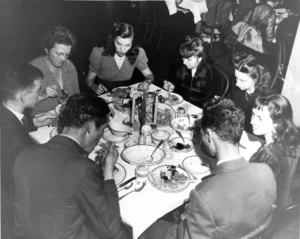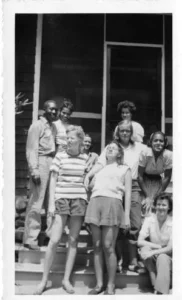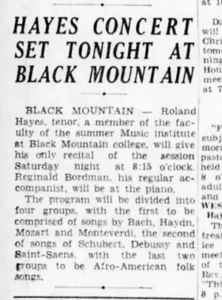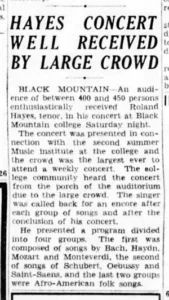
Integration at Black Mountain College
by Anne Chesky Smith
“If Black Mountain College wants to have Negro students, it will have them; if it does not find them, it is because it does not really want them. This may seem a hard statement — I nevertheless am convinced of it.” – Edward Lowinsky

Jacob and Gwendolyn Lawrence (back left) at Black Mountain College.

August 4, 1945

In the Jim Crow South, integration was not easy, even for one of the most progressive educational institutions in the United States at the time – Black Mountain College. The college, founded in 1933 at Blue Ridge Assembly in Black Mountain, discussed the subject of race throughout its 24-year history, beginning in its very first year.
In 1933, a father of one of the students, who was a professor at Yale University, was traveling the South with several of his graduate students – one of whom was Black. He asked the college if they could stop in for a few days.
Immediately the community began an intense discussion of whether the student should be housed on campus with everyone else, or whether he should be put up with a local African American family.
Though many at the college were in favor of allowing the student to stay at the school, others felt that allowing even temporary integration might be the last straw for the surrounding community, which already viewed Black Mountain College as a haven for free love and Communism. In the end, the student was housed with a local family.
The issue would be broached several times throughout the 1930s, but did not come to a true head until 1944, after the college had relocated to its Lake Eden campus, when the students voted 2 to 1 to admit African American students as full members of the college community.
The faculty, however, was more cautious and less idealistic – and though almost no one felt that they should exclude quality students due to the color of their skin, half of the faculty wanted to continue to err on the side of caution. They reasoned that Black Mountain College had not been set up to challenge segregation and that doing so could potentially cause the demise of the school.
At first, many of the opposing faculty cited a North Carolina law that did not allow segregation in schools, but when it turned out that the law did not exist, an abundance of other reasons were found. There was fear of violence against college personnel, arson against the college property, boycott of Black Mountain College students and faculty by local businesses, increased ill-favor of local citizens, and threats to receiving accreditation – which would discourage veterans attending on the GI Bill (a big source of funding for the school at the time).
The integration supporters on the faculty had their own ideas of what desegregation would mean for the college. They listed the following in support of their goal: the satisfaction of living up to their ideals, greater respect from their students, inclusion of the intellectual and artistic contribution of Black students, greater financial support from approving individuals, and an already approved $2,000 from the Rosenwald Fund, which helped finance educational opportunities for Black Americans.
One faculty member, Bob Wunsch could, “see the dynamite in the proposal to take Negro students,” so he wrote to his friend, Black author and anthropologist Zora Neale Hurston, asking for advice. He wrote, “Is now the right time to make this radical departure from Southern procedure?”
Hurston responded, “Confidentially, some of these Left-wing people get me down. They always want to spring some sensation that gives them great publicity but which does us no good.”
In the end, the school made a cautious compromise and agreed to allow a well-qualified, graduate-level Black woman – Alma Stone Williams – to attend the 1944 summer program at the college. Williams would later say of the college: “I was at home among these people: students and teachers, Northern and Southern, regulars and institute members, Americans and foreigners, Thomas Mann’s daughter and Sigmund Freud’s daughter-in-law. The arts brought us together, and differences were not so much threatening as they were attracting.”
There was little backlash from the surrounding non-college community, though a few faculty members suspected that unhappy locals were responsible for setting fires in the surrounding woods (though they never pursued substantiating these claims).
Williams recalled her time in Western North Carolina: “I had only a few occasions in 1944 to interact with people in Asheville or the town of Black Mountain. I had little need for business or entertainment except for a regular appointment with an Asheville hairdresser. The self-sufficient quality of life on the Lake Eden campus was not unusual then. Gasoline and mass transportation were controlled by the needs of wartime, and a national polio epidemic made people wary of strangers. I was highly visible at the Black Mountain College concerts and lectures which were well attended by music- and art-lovers from surrounding areas. No one seemed to show that my presence was invasive or upsetting.”
Only one student and one faculty member left the college in light of the decision to cautiously integrate. And so, with Williams’ tenure at the college deemed a success, in 1945, the college invited famous Black musicians Carol Brice and Roland Hayes to teach at the summer institute, and enrolled Sylvesta Martin as Black Mountain College’s first full-time Black student. Biology professor Percy H. Baker became the college’s first full-time African-American faculty member.
Though Roland Hayes was only at the college for three weeks, the concert he gave near the end of his stay attracted over 400 people, including at least 300 white people from the surrounding community and dozens of African Americans. The seating was integrated. The Asheville Citizen advertised the concert and reported on its success the following day.
The wife of a visiting faculty member remembered, “(Roland Hayes’) concert last Saturday was beautiful beyond words. … It is not the voice alone; it is the whole man, the musician, the artist, the perfection of training as a matter of course. … And the astonishing thing is, that he sings Bach and negro spirituals equally … with equal fervor and religious feeling, understanding, deep conviction.”
But fear and uncertainty of the surrounding community’s reaction to integration at the college persisted. In 1946, well-known artists and spouses, Jacob Lawrence and Gwendolyn Knight Lawrence, came to teach at the college during the summer session. They took a private car to campus and never left Lake Eden during their stay.
In 1947, eight years before Chief Justice Earl Warren declared “separate educational facilities … inherently unequal” and ordered the desegregation of schools, Black Mountain College made the decision to admit students without regard to skin color.
With this official policy of integration in place, a faculty member in charge of admissions wrote to a prospective Black student in 1947, “There is no attempt to ‘hide’ our activities in race relationship, nor do we foist them on the local communities. … (Black students) realize, with us, the progress forward must necessarily be slow.” So, when outside the college campus, Black students were told to “obey the transportation, eating, etc. laws.”
Few African American students would choose to attend Black Mountain College. A faculty member in favor of integration, Edward Lowinsky, wrote: “If Black Mountain College wants to have Negro students, it will have them; if it does not find them, it is because it does not really want them. This may seem a hard statement — I nevertheless am convinced of it.”
Lowinsky continued: “Our efforts to contribute in a small way to better interracial living may not be just another one of those fads of which we were so often accused. It must be an effort as hard and consistent as the problem to the solution of which it wants to contribute.”
Over the next couple years the faculty members who had been the main proponents of integration, including Lowinsky, left the college. With no other faculty left willing to take on the hard work of integration, attempts at recruitment of Black students and faculty stopped. This became one of the many factors that contributed to the school’s low enrollment and indebtedness in the late ‘40s and early ‘50s that would eventually lead the school to close its doors in 1957.
Still, this early effort at integrating in a segregated South was a meaningful step forward for many. In her memoir, Alma Stone Williams wrote of her time at the college during the summer of 1944: “It is important to recognize Black Mountain College’s role in the history of integration in America. … Though the decision to enroll (me) was not unanimous, it was willing to take considerable risk to bring me into the community. In this intellectual, friendly, artistic, naturally beautiful environment, they gave me the freedom to learn beside them and to be myself.”
Anne Chesky Smith is the executive director of Asheville Museum of History.
Read at Asheville Citizen-Times.com
